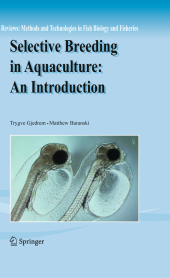 Neuerscheinungen 2013Stand: 2020-01-07 |
Schnellsuche
ISBN/Stichwort/Autor
|
Herderstraße 10
10625 Berlin
Tel.: 030 315 714 16
Fax 030 315 714 14
info@buchspektrum.de |

Matthew Baranski, Trygve Gjedrem
(Beteiligte)
Selective Breeding in Aquaculture: an Introduction
2013. xiv, 221 S. XIV, 221p. 235 mm
Verlag/Jahr: SPRINGER NETHERLANDS 2013
ISBN: 9400736770 (9400736770)
Neue ISBN: 978-9400736771 (9789400736771)
Preis und Lieferzeit: Bitte klicken
To broaden the appeal of selective breeding, the authors, from a leading aquaculture research center, use the results of numerous studies showing that the high fecundity and genetic variation in most aquatic species can lead to rapid and dramatic improvements.
The foundation of quantitative genetics theory was developed during the last century and facilitated many successful breeding programs for cultivated plants and t- restrial livestock. The results have been almost universally impressive, and today nearly all agricultural production utilises genetically improved seed and animals. The aquaculture industry can learn a great deal from these experiences, because the basic theory behind selective breeding is the same for all species. The ?rst published selection experiments in aquaculture started in 1920 s to improve disease resistance in ?sh, but it was not before the 1970 s that the ?rst family based breeding program was initiated for Atlantic salmon in Norway by AKVAFORSK. Unfortunately, the subsequent implementation of selective breeding on a wider scale in aquaculture has been slow, and despite the dramatic gains that have been demonstrated in a number of species, less than 10% of world aquaculture production is currently based on improved stocks. For the long-term sustainability of aquaculture production, there is an urgent need to develop and implement e- cient breeding programs for all species under commercial production. The ability for aquaculture to successfully meet the demands of an ever increasing human p- ulation, will rely on genetically improved stocks that utilise feed, water and land resources in an ef?cient way. Technological advances like genome sequences of aquaculture species, and advanced molecular methods means that there are new and exciting prospects for building on these well-established methods into the future.
Domestication and the Application of Genetic Improvement in Aquaculture.- The Success of Selective Breeding in Aquaculture.- The Theoretical Basis for Breeding and Selection.- Initiating Breeding Programs.- Breeding Strategies.- Selection Methods.- Mating Design.- Estimation of Breeding Values.- Genotype-Environment Interaction.- Measuring Response to Selection.- Structure of Breeding Programs.- Undesirable Side Effects in Breeding Programs.- Biotechnology in Breeding Programs.- Reproduction Techniques.- Economic Benefits of Breeding Programs.


